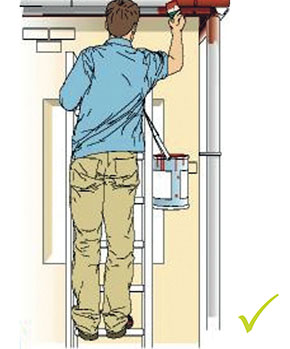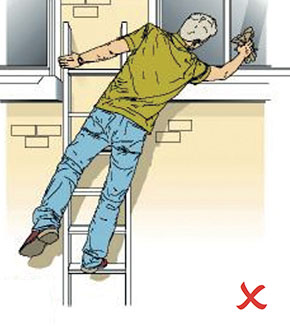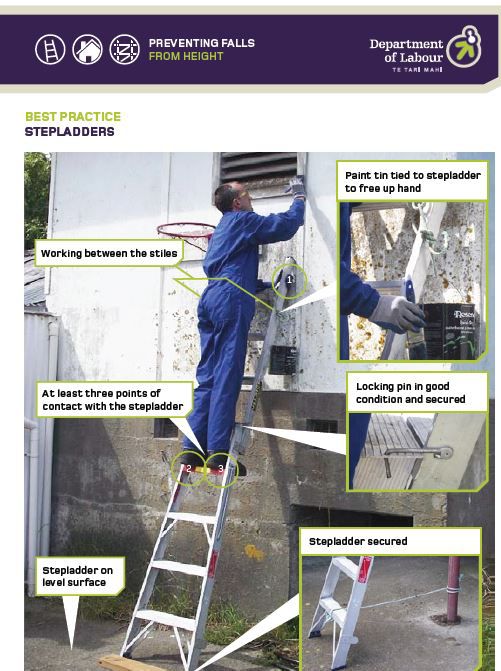How to correctly use a ladder
You've got a painting project planned and you've got some high places to paint, so do you know how to choose a safe ladder and do you know how to use the ladder safely?

Correct – user maintaining three points of contact with the ladder

Incorrect – user overreaching and not maintaining three points of contact
Ladder safety: the basics
- Using a ladder is much safer than balancing on boxes or chairs to gain height. But there is a risk you will fall and be injured.
- Assemble the ladder correctly, make sure it is steady and use it safely.
Before you buy a ladder
- Discuss what you will use the ladder for with a retailer so they can advise the best ladder to meet your needs.
- Check your ladder meets a relevant safety standard (AS/NZS 1892.1:1996 is the most common standard).
- Ask the retailer to demonstrate how to use the ladder properly before you buy. Pay particular attention to features that indicate when hinges are locked.
How to use a ladder safely
- Read the instructions carefully and practise opening and closing the ladder until you are confident that it is operating correctly and safely.
- Check you have assembled the ladder correctly, and read the instructions for use. Make sure all locking clips are secure. A stepladder should have its two stay bars firmly in place.
- If in doubt, do not use your ladder – go back to the retailer or seek professional advice.
Check the condition of your ladder
- If it is rusty, parts are missing, or security bars or clips aren’t working properly, do not use it. If parts are worn or not working properly, repair or replace them. Tighten any loose bolts.
Make sure your ladder is steady
- Stand the ladder on a firm, level base. If the ground is uneven, use a suitable block or board to keep the ladder upright and stable.
- Wear sturdy shoes, and do not use a ladder when barefoot.
- Lock any doors you are working around so nobody can open a door into your ladder and tip you over.
Keep away from live electricity
- Keep metal ladders and metal parts well away from live electricity outlets. Have your electricity retailer shut off the power if you need to work close to electric lines.
- Remember, metal ladders or wooden ladders with metal parts conduct electricity.
Climbing and descending
- Face the ladder when climbing and descending.
- Do not use the top two steps of the ladder.
- Have a helper hold the lower part of the ladder whenever possible.
- Keep your body centred between the rails of the ladder at all times or you may lose your balance.
- Move the ladder to continue a task – do not over reach.
- Remember the “one in four” safety rule if you are leaning the ladder: the bottom should be one measure out for every four measures in height.
- Maintain three points of contact when climbing up or down – use two hands and one foot, or two feet and one hand.
Storing your ladder
Before you put the ladder away:
- check that it is clean and dry
- keep children safe – store your ladder away after use
- keep your house safe – do not leave your ladder outside.
Ladder Safety information provide by Consumer Protection for more information >>> click here
Preventing falls from heights
Information provided by the Department of Ladder - download PDF versions (by clicking on the image or links below)
Worksafe NZ - This good practice guide will provide practical guidance to employers, contractors, employees and all others engaged in work associated with working at height. See the full guide: Working at height in New Zealand
If you feel you may be out of your depth with your painting project, why not contact us, you'll be surprised how cost effective it is to outsource your painting projects.


